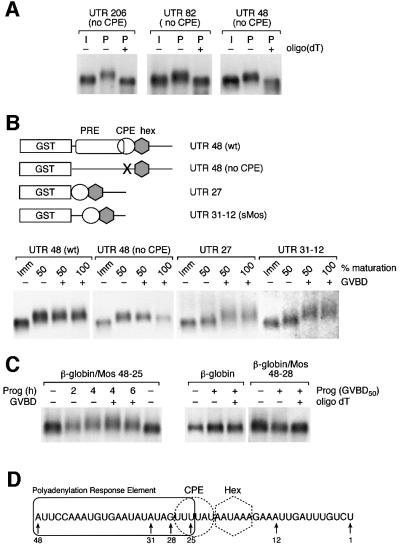Fig. 3. Identification of a novel Mos 3′ UTR regulatory element. (A) Truncation analysis of the Mos 3′UTR. Immature oocytes were injected with different lengths of the CPE-disrupted Mos 3′ UTR, and the ability of progesterone to induce polyadenylation (retarded mobility) was analyzed by northern blot. Total RNA was prepared from pools of oocytes when 50% of progesterone-stimulated oocytes had undergone GVBD. CPE-independent polyadenylation was retained within the last 48 nt of the Mos UTR. (B) Upper panel, schematic representation of the UTR constructs employed. The GST open reading frame (open box) was fused to the Mos 3′ UTR. The polyadenylation hexanucleotide (gray hexagon), CPE (open circle) and PRE (open rectangle) are also indicated. Mutational disruption of the CPE is indicated by an ‘X’. UTR 27 lacks Mos UTR sequence 5′ of the CPE, and sMos encompasses nucleotides 31–12 of the wild-type Mos UTR (Stebbins-Boaz et al., 1996). Lower panel, northern blot of wild-type and mutant Mos UTR-injected oocytes. When 50% of the oocytes had undergone GVBD, oocytes were segregated into pools that had either had a white spot at the animal pole (GVBD+) or had not (GVBD–), and total RNA was extracted. Total RNA was also prepared when all the oocytes had matured (100% GVBD) and from time-matched immature (Imm) oocytes. Wild-type 48 UTR and 48 UTR (no CPE) polyadenylation (retarded mobility) occurred prior to GVBD. CPE-directed polyadenylation of the Mos UTR 27 RNA and sMos RNA was observed predominantly after GVBD. (C) Northern blot of β-globin/Mos UTR chimeras. Total RNA was prepared from wild-type and mutant β-globin UTR-injected oocytes at the indicated times. Fifty percent of the oocytes had undergone GVBD (GVBD50) at 4 h. Where indicated, oligo(dT) and RNase H were used to remove any poly(A) tails from the UTR reporter constructs (oligo dT +). (D) Schematic representation of the relative positions of the polyadenylation response element (rectangle), CPE (circle) and polyadenylation hexanucleotide (dotted hexagon) sequences within the last 48 nt of the Mos UTR. The numbers indicate the position relative to the site of poly(A) addition (designated 1).

An official website of the United States government
Here's how you know
Official websites use .gov
A
.gov website belongs to an official
government organization in the United States.
Secure .gov websites use HTTPS
A lock (
) or https:// means you've safely
connected to the .gov website. Share sensitive
information only on official, secure websites.
